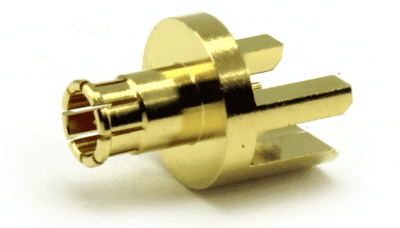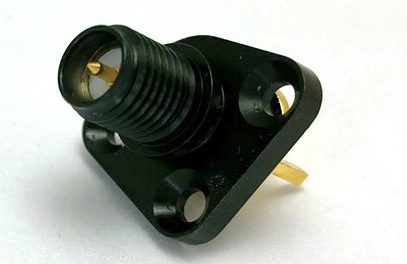The Case for Custom RF Connectors
To meet the needs of high-frequency and high-performance applications as well as those with smaller, lighter, and more dense packaging, it is often necessary to modify existing connector designs or design completely new connectors.

As RF/microwave technologies find increasing use in high-speed digital data exchange applications, the mix of connector and cable technologies included in these systems are becoming more complex. The next generation of wireless technology, higher data rates, and high integrity interconnects will require higher performance capabilities in all RF interconnections.
Custom RF Connector Design
The need to reduce size and weight has also created challenges for the connector industry as it innovates to keep up with the miniaturization of products and systems. This has also been influenced by the need to increase connector packaging density to allow for greater system capacity within existing space confines.
RF interconnect product design and manufacturing is constantly changing and expanding to improve designs that are tested to meet the required high frequency performance, high durability cycles, and high data rate capability.
Signal integrity refers to the challenge of ensuring all connectors and cables carry uncorrupted signals. Variations in power and ground voltage and crosstalk between cables introduce noise, which can seriously affect operation and data transmission.
To meet the needs of these high frequency and high-performance applications, often in smaller, lighter, more dense packaging, it has become necessary to modify existing connector designs or design completely new connectors.
RF interconnects for high-speed digital applications require high levels of isolation and protection from all electromagnetic interference. The design of the connector and the base material and plating type used are a major factor in ensuring low interference. Effective shielding and connector quality are therefore of great importance.

Micro BNC 75 ohm PCB End-Launch Push-On Plug from COAX Connectors. This true 75 ohm plug is designed to mate to a micro-BNC jack without a coupling nut in applications in which space is an issue.
Because many high-speed digital applications have high interconnect densities, small pitch distances are required, hence push-type connectors and connector/cable assemblies that allow many connections are common.
It is necessary to reduce the delay between the separate parallel digital signals and this will require very closely matched transmission line lengths.
Resonances usually affect return loss and crosstalk and must be minimized. In connector design this is achieved by careful design of the wipe between the two mating pins and providing an effective return path.
In cable assemblies, connectors, and PCB traces, structural return loss can occur due to manufacturing imperfections and design errors. Spotting design flaws that might produce structural return loss can ensure the component or interconnect system will work as designed and that signals will not be degraded as they pass through an interconnect.

N-Type Jack to SMA Jack from COAX Connectors feature four holes and 1 square flange adaptor made from brass and plated with a black non-reflective plating.
Structural return loss is common in poorly manufactured coaxial cables; variations in impedance along the cable length can cause signal reflections for a wave travelling along the cable. These impedance variations can arise from variations in conductor thickness, spacing between the shielding, or both. It is therefore vital that only quality cables are used to avoid structural return loss.
A well-designed RF coaxial connector made with the correct materials for the application and with greater precision will ensure the signal path is uninterrupted along the complete path, from the first connector, through the PCB and/or cable, to the last connector, and on to the next device.
Increasing capacity demands have compelled the connector industry to develop smaller high precision connectors. In some cases, the demand for greater packaging density has led to the design of connectors capable of four or more times the number of connectors in the equivalent space on product housings.
The use of CAD and simulation software has enabled connector designers to speed up the design process. Backed up with a test laboratory, designs are proven before any material is used to create test samples to ensure that the result is a robust, cost-effective product.
Once samples are produced, rigorous testing methods allow the manufacturer to fine-tune new products to ensure the highest possible performance is achievable and repeatable during volume manufacturing.
A completely new connector design is not always necessary, as in some situations a redesign, upgrade, or modification of an existing product may be all that is required to meet the needs of the product or system. The same design and testing methods are used to modify existing products.

COAX Connectors SMA Reverse Polarity, Straight 3-Hole Flange Mount PCB Jack, IP68 sealed unmated with a black non-reflective nickel and a gold-plated contact and PCB solder body.
Materials for Custom RF Connectors
Higher-frequency capability can often be achieved by a change of materials used in the connector. By changing the body and insulator materials of an SMA RF connector from brass and acetal homopolymer (Polyoxymethylene POM) to stainless steel and PTFE, for example, it is possible to increase the frequency range upper limit from 11GHz to 26GHz.
Careful use of CAD along with a change of materials means it is possible to reduce the dimensions and weight of some existing connector designs to increase packaging density and allow the use of more channels without increasing the weight of the system.
The increase in channels and connectors has meant that channel or port identification to reduce the possibility of misconnection is becoming more important. This can be achieved by many methods, including colored washers and printed labels to allow for easy identification and coupling of the correct cables to the correct port.
While the use of standard existing product has advantages in terms of availability and cost, a connector manufacturer with a highly skilled design team using the latest design, simulation, and test equipment can not only make the process of designing a modified or new connector quicker and more accurate, it can also make the product cost-effective and quickly available.
To learn more about custom connectors, visit COAX Connectors Ltd.
Like this article? Check out our other Custom and RF and Coax articles, our Special Topics Page, and our 2023 and 2022 Article Archives.
Subscribe to our weekly e-newsletters, follow us on LinkedIn, Twitter, and Facebook, and check out our eBook archives for more applicable, expert-informed connectivity content.

